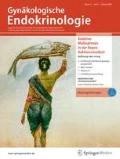Zusammenfassung
Die ersten Publikationen der Women’s-Health-Initiative(WHI)-Studie 2002 und das Bekanntwerden von negativen Auswirkungen einer menopausalen Hormontherapie (MHT) auf die Gesundheit, vor allem im kombinierten Therapiearm mit konjugierten equinen Östrogenen (CEE) plus Medroxyprogesteronacetat (MPA), führten zu einem dramatischen Umdenken in Bezug auf den Einsatz einer MHT. Es wurde nach Alternativen gesucht, von denen man sich eine größere Sicherheit versprach. Zu diesen gehören die bioidentischen Hormone. Als bioidentische Hormone werden Hormone bezeichnet, die strukturell und funktionell den vom menschlichen Körper produzierten Hormonen entsprechen. Auch diese haben ein Risikoprofil, das je nach Zusammensetzung, Applikationsweg und Dosierung variiert. Die Applikation bioidentischer Östrogenpräparate zur MHT ist in Europa mittels Tabletten, Cremes, Gels, Patches, Vaginalring oder auch Sprays möglich. Bioidentische Hormone sind gleich effektiv in der Reduktion vasomotorischer Beschwerden wie artifizielle Hormone. Bei Beginn innerhalb der ersten 10 Jahre nach der Menopause und vor dem 60. Lebensjahr zeigt sich ein kardioprotektiver Effekt. Die orale Applikation ist mit einem höheren Thromboembolierisiko verbunden als die transdermale Anwendung. Bei Patientinnen mit Uterus in situ ist zusätzlich die sequenzielle oder kontinuierliche Gabe von Progesteron zum Schutz des Endometriums obligat. Mikronisiertes Progesteron und Dydrogesteron scheinen hierbei ein günstigeres Profil hinsichtlich des Brustkrebsrisikos zu besitzen, gehen bei Langzeitanwendung von über 5 Jahren aber möglicherweise mit einem höheren Endometriumkarzinomrisiko einher.
Abstract
With the first publications of the Women’s Health Initiative (WHI) Study 2002 and the negative results especially in the combined arm with conjugated equine estrogens (CEE) plus medroxyprogesterone acetate (MPA) with increased breast cancer and thromboembolism, research was focused on safer alternatives; one of these were bioidentical hormones. Bioidentical hormones have the same structure as the ones produced by the human body. Although the terminus “bio” may symbolize that these hormones are healthier, we have to be aware that these hormones also have a risk profile depending on composition, dosage and administration. Bioidentical hormones are available in Europe as tablets, gels, patches, creams and sprays or vaginal rings. Bioidentical hormones are as effective against vasomotoric symptoms as the artificial products. They are cardioprotective when the therapy is started in the first 10 years after menopause. Oral administration has a higher risk for thromboembolism than transdermal administration. With uterus in situ sequential or continuous use, both with progesterone, is obligatory. Micronized progesterone and dydrogesterone seem to have a better risk profile regarding breast cancer, but may increase the risk of endometrial cancer.
Literatur
Manson JE et al (2013) Menopausal hormone therapy and health outcomes during the intervention and extended poststopping phases of the Women’s Health Initiative randomized trials. JAMA 310(13):1353–1368
Birkhäuser M (2018) Menopausale Hormontherapie aus heutiger Sicht. Gynäkologie 3:18–22
Bhavnani BR, Staczyk FZ (2014) Pharmacology of conjugated equine estrogens: efficacy, safety and mechanism of action. J Steroid Biochem Mol Biol 142:16–29
Whelan AM, Jurgens TM, Trinacty M (2011) Defining bioidentical hormones for menopause related symptoms. Pharm Pract 9(1):16–22
Pinkerton JA (2014) What are the concerns about custom-compounded bioidentical hormone therapy? Menopause 21(12):1298–1300
Baber RJ, Panay N, Fenton A (2016) 2016 IMS Recommendations on women’s midlife health and menopause hormone therapy. Climacteric 19(2):109–150
De Villiers TJ et al (2016) Revised global consensus statement on menopausal hormone therapy. Climacteric 19(4):313–315
Hickey M, Elliot J, Davison SL et al (2012) Hormone replacement therapy. BMJ 334:e763
Windler E, Ortmann O (2018) 18 Jahre Mortalitätsdaten zu HRT – mehr Sicherheit für die Anwendung. Frauenarzt 59(9):688–689
Manson JE et al (2017) WHI investigators: menopausal hormone therapy and long-term all cause and cause specific mortality: the Women’s Health Initiative randomized trials. JAMA 318(19):927–938
Hodis N et al (2016) Vascular effects of early versus late postmenopausal treatment with estradiol. N Engl J Med 374(13):1221–1231
Schierbeck LL et al (2012) Effect of hormone replacement therapy on cardiovascular events in recently postmenopausal women: randomised trial. BMJ 345:e6409
L’Hermite M (2017) Bioidentical menopausal hormone therapy: registered hormones (non-oral estradiol ± progesterone) are optimal. Climacteric 4:331–338
Morville R (1982) The bioavailability of natural progesterone given by mouth. Measurement of steroid concentrations in plasma, endometrium and breast tissue. J Gynecol Obstet Biol Reprod 11:355–363
The Writing Group for the PEPI Trial (1996) Effects of hormone replacement therapy on endometrial histology in postmenopausal women. The postmenopausal estrogen/progestin interventions (PEPI) trial. JAMA 275(5):370–375
Fournier A, Dossus L, Mesrine S, Vilier A, Boutron-Ruault MC, Clavel-Chapelon F, Chabbert-Buffet N (2014) Risks of endometrial cancer associated with different hormone replacement therapies in the E3N Cohort, 1992–2008. Am J Epidemiol 180(5):508–517
Mueck AO (2015) Systemische Progesterontherapie – transdermal? Gynäkologische Endokrinologie 13:50–56
Stute P, Neulen J, Wildt L (2016) The impact of micronized progesterone on the endometrium: a systematic review. Climacteric 19(4):316–328
Bakken K et al (2011) Menopausal hormone therapy and breast cancer risk: impact of different treatments. The European prospective investigation into cancer and nutrition. Int J Cancer 128(1):144–156
Author information
Authors and Affiliations
Corresponding author
Ethics declarations
Interessenkonflikt
K. Blickenstorfer gibt an, dass kein Interessenkonflikt besteht.
Für diesen Beitrag wurden von der Autorin keine Studien an Menschen oder Tieren durchgeführt. Für die aufgeführten Studien gelten die jeweils dort angegebenen ethischen Richtlinien.
Additional information
Redaktion
B. Imthurn, Zürich
A.O. Mueck, Tübingen
O. Ortmann, Regensburg
Rights and permissions
About this article
Cite this article
Blickenstorfer, K. Vorteile bioidentischer Sexualhormone in der systemischen menopausalen Hormontherapie. Gynäkologische Endokrinologie 18, 31–34 (2020). https://doi.org/10.1007/s10304-019-00287-w
Published:
Issue Date:
DOI: https://doi.org/10.1007/s10304-019-00287-w

